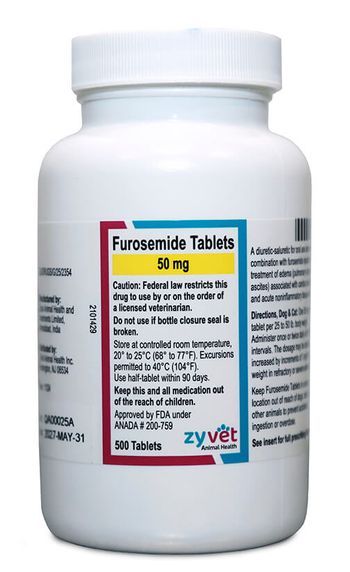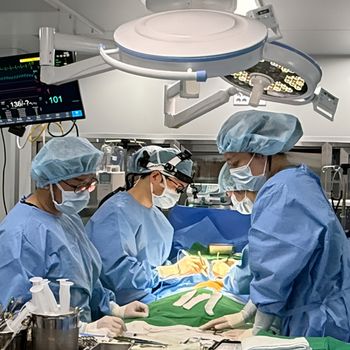
Recording and interpreting ECGs (Proceedings)
The electrocardiogram (ECG) is a commonly employed diagnostic tool to help in the evaluation of cardiac arrhythmias, to help detect cardiac chamber enlargement, and to identify electrolyte abnormalities.
The electrocardiogram (ECG) is a commonly employed diagnostic tool to help in the evaluation of cardiac arrhythmias, to help detect cardiac chamber enlargement, and to identify electrolyte abnormalities. The ECG may also detect alterations of sympathetic and parasympathetic tone, identify myocardial inflammation, ischemia and necrosis, evaluate drug effects and reflect the presence of pericardial disease. The key to understanding electrocardiograms is to develop a systematic approach for the determination of heart rate, rhythm, and to recognize patterns of chamber enlargement. This handout and the associated lecture will focus on the recognition of common physiologic and pathologic cardiac arrhythmias.
Cardiac conduction system
The cardiac conduction system is a group of specialized cells that exhibit the property of automaticity. These cells are able to depolarize spontaneously and with regularity, and hence serve as the physiologic pacemaker. The normal cardiac pacemaker is a group of specialized cells located near the junction of the cranial vena cava and right atrium termed the Sinoatrial (SA) Node. The remainder of the conduction system is comprised of atrial internodal tracts, the atrioventricular (AV) node, the His bundle, the right and left bundle branches, and the Purkinje fiber network. The SA node displays the most rapid rate of spontaneous depolarization (70-140 beats/minute in dogs) and hence controls the heart rate. Junctional cells within the region of the AV node spontaneously depolarize between 40-60 beats/minute while ventricular cells with automaticity depolarize between 20-40 beats/minute in dogs.
Normal propagation of the electrical impulse
The specialized cells within the SA node initiate the cardiac impulse, which travels through internodal tracts to depolarize the right and left atria. The AV node is then depolarized and carries the impulse to the ventricles, but it conducts electrical activity more slowly to allow proper atrioventricular synchrony. The His bundle, right and left bundle branches and the Purkinje fibers depolarize finally followed by cell to cell conduction through the ventricular muscle.
Electrical activity and the electrocardiogram
Individual electrical events within the heart correspond to an electrical potential that may be measured by the surface ECG. The P wave represents depolarization of the atria while the QRS complex represents depolarization of the ventricles. The PR interval is the time from atrial depolarization to ventricular depolarization. The T wave represents ventricular repolarization. Ventricular depolarization must be followed by repolarization, therefore every QRS complex must have a T wave.
Interpretation of the ECG
A systematic approach to the evaluation of the ECG will ensure against overlooking important abnormalities. The following characteristics should be evaluated in every ECG. Familiarity with the normal parameters for the ECGs of the various species is, of course, essential for accurate interpretation.
Determine the heart rate
If the heart rate is regular, the number of small boxes (mm) between QRS complexes can be divided into 3,000 (at 50 mm/sec) or 1,500 (at 25 mm/sec) to find the instantaneous heart rate. The heart rhythm in animals, especially in dogs, is frequently irregular. In this circumstance the more accurate average heart rate is found by counting the number of beats in a known time interval and multiplying appropriately. Single channel ECG paper on analog recorders is usually marked by a vertical line at the top of the paper at 75 mm (1 mm = 1 small box) intervals. At a paper speed of 50 mm/sec, 75 small boxes (equivalent to 15 large boxes) represent 1.5 seconds so the heart rate per minute can be calculated by counting the number of QRS complexes in 1.5 seconds and multiplying by 40. At a paper speed of 25 mm/sec, 75 small boxes (15 large boxes) represent 3.0 seconds and the number of QRS complexes in 3.0 seconds is multiplied by 20. Many of the newer digital ECG machines calculate heart rate automatically.
Determine the cardiac rhythm
The heart's rhythm is evaluated by inspection of the ECG and the findings are correlated with the physical findings. Analysis of the heart's underlying rhythm should include the following steps.
• What is the rhythm (including the regularity and the relationship among complexes)?
· Regular?
· Regularly irregular with a consistent and repeating pattern to the variation in the rate?
· Irregularly irregular where the rhythm is chaotic and there is no pattern to the irregular nature of the rhythm?
· Paroxysmal (which is defined as a sudden outburst)? When applied to the ECG, a paroxysm refers to a series of rapid ectopic beats, which begins and ends abruptly. The series may be as short as 3 beats or may last for minutes to hours.
· What is the relationship between the P and QRS complex? Is there a P wave for every QRS complex? Is there a QRS complex for every P wave? Is the duration of time between the various components (P-R interval, Q-T interval) normal? Is the duration of time between the various complexes consistent?
• Where do the cardiac impulses originate (site of origin)? The four possible choices include:
· The sinoatrial (SA) node
· The atria
· The atrioventricular (AV) node/junctional
· The ventricles and His-Purkinje system
Impulses originating from the SA node, atria or AV node are grouped together under the heading supraventricular while impulses from the ventricles or His-Purkinje system are termed ventricular. Supraventricular beats should maintain a relatively tall, upright and narrow QRS complex because the impulse must utilize the His-Purkinje system to transmit the impulse to the ventricles. Therefore the ventricular muscle depolarizes uniformly with a set activation sequence. But when impulses arise from the ventricles or terminal branches of the His-Purkinje system they are slowly transmitted from individual myocardial cell to myocardial cell. This produces a relatively wide and bizarre QRS-T complex.
• What are the ventricular and atrial rates?
· Too fast (tachycardia)
· Too slow (bradycardia)
• What is the temporal relationship between any ectopic beats and the underlying heart rhythm?
· Premature beats are defined as ectopic beats that occur early in the sequence of normal beats, meaning the R-R interval from the preceding normal beat to the ectopic beat is shorter than the prevailing R-R interval. Premature beats are formed when the ectopic focus depolarizes more rapidly than normal, overrides the sinus node and assumes control of the heart rate for one or more beats.
· Escape beats are defined as ectopic beats that occur after a pause in the sequence of normal beats, meaning the R-R interval from the preceding normal beat to the ectopic beat is longer than the prevailing R-R interval. The ectopic site assumes control of the electrical activity of the heart by default because the SA node fails to discharge or the sinus impulse is not properly conducted to the rest of the heart.
Guidelines to the interpretation of cardiac rhythm
• Identify the P waves that correspond to atrial depolarization. Determine if P waves are present, if they are uniform, and determine their relationship with the QRS-T complex.
• Identify the QRS-T complexes and evaluate their configuration (supraventricular versus ventricular), uniformity, and their association with the P waves.
• Determine the PR, and R-R intervals to evaluate for conduction disturbances or alterations in the parasympathetic/sympathetic systems.
Sinus rhythm
Following the guidelines outlined above:
• P waves are uniform, one present for every QRS-T complex
• QRS-T complexes are supraventricular and uniform, one present for every P wave
• The PR and R-R intervals are relatively constant
Sinus arrhythmia
Sinus arrhythmia is a regularly irregularly rhythm originating from the sinus node that follows the normal cardiac conduction system. Because the normal cardiac conduction system is utilized the PR interval is constant, and the QRS-T complexes are supraventricular in origin. Sinus arrhythmia is usually associated with respiration, where inspiration causes reflex inhibition of parasympathetic tone, and increases the heart rate. Sinus arrhythmia is a normal finding in dogs, especially in brachycephalic breeds, presumably from the increased forces of inspiration required due to large airway obstruction.
• P waves are uniform, one present for every QRS-T complex
• QRS-T complexes are supraventricular and uniform, one present for every P wave
• The PR interval is constant, but R-R intervals are variable, this irregular rhythm is phasic and may coincide with respiration, the R-R interval shortens with inspiration and widens with expiration
Sinus tachycardia
Sinus tachycardia is a regular rhythm that originates from the SA node and follows the normal cardiac conduction system. The QRS-T complexes are supraventricular in origin and the PR interval is normal. Occasionally the heart rate becomes so fast the P waves are buried in the preceding QRS-T complex and are not visible. Sinus tachycardia may be associated with a variety of cardiac and non-cardiac conditions including increased sympathetic or decreased parasympathetic tone, fever, anemia, shock, congestive heart failure and hyperthyroidism. Treatment is rarely required and is aimed at determining and treating the underlying etiology.
• P waves are uniform, one present for every QRS-T complex, at very high heart rates P waves may be hidden
• QRS-T complexes are supraventricular and uniform, one present for every P wave
• The PR, P-P, and R-R intervals are relatively constant
Sinus arrest
Sinus arrest is a pause in the cardiac rhythm and represents failure of SA nodal depolarization. This arrhythmia may be seen physiologically in normal dogs as an exaggerated form of sinus arrhythmia associated with variations in vagal tone. Sinus arrest may also be associated with pathologic conditions including injury or ischemia of the SA node, hyperkalemia, or with surgical manipulation that increases parasympathetic tone. Prolonged periods of sinus arrest may manifest in weakness or syncope, such as those clinical signs associated with Sick Sinus Syndrome reported most commonly in Miniature Schnauzers. Sinus arrest is defined as a pause on the ECG that is equal to or greater than twice the normal R-R interval.
• No P waves present
• No QRS-T complexes present
• No PR interval to calculate
Ventricular premature complexes
Ventricular Premature Complexes (VPCs) are one of the most common cardiac arrhythmias detected in companion animals. VPCs represent a ventricular ectopic site that depolarizes more rapidly than the SA node. This premature ventricular depolarization propagates between individual myocardial cells without using the normal cardiac conduction system. The resultant slow electrical transmission results in conduction delay with widening and alteration of the QRS-T morphology. Cardiac causes of VPCs include inflammatory, degenerative, traumatic, ischemic, or neoplastic myocardial disease. Non-cardiac causes include hypoxia, anemia, sepsis, gastric dilatation-volvulus, pancreatitis, and drugs including digitalis and anesthetic agents (especially short-acting thiobarbiturates). Visceral and orthopedic manipulation during surgery may also induce ventricular premature contractions.
• P wave is not present with the premature beat
• QRS-T complex is wide and bizarre, lacks a P wave and occurs prematurely (less than one R-R interval from the preceding sinus beat)
• No PR interval to calculate, VPCs may occur as singlets, pairs, or in runs; greater than three VPC's together constitutes ventricular tachycardia
Escape beats
Escape beats are electrical impulses formed by a subsidiary pacemaker within the cardiac conduction system after the SA node fails to depolarize. These beats occur during sinus bradycardia, sinus arrest or with advanced atrioventricular block and represent a normal mechanism for maintaining the heart rhythm when the normal pacemaker fails. They may originate from junctional cells associated with the AV node, or from ventricular cells that display automaticity. Impulses originating from the junctional cells will propagate throughout the ventricle utilizing the normal conduction pathway and therefore the QRS-T morphology will be supraventricular. The impulses that originate from the ventricle do not utilize the conduction system, but instead propagate between individual myocardial cells with a resultant wide and bizarre QRS-T complex. It is very important to differentiate between ventricular premature complexes and ventricular escape beats. Both will display an abnormal QRS-T morphology without an associated P wave, but ventricular escape beats occur after a pause or during AV block while VPCs occur prematurely. Suppression of escape beats is contraindicated as they are the only impulses maintaining ventricular activation.
Junctional escape beat
• P waves are not present with the escape beat
• QRS-T complex is supraventricular but is not preceded by a P wave, the QRS-T complex usually occurs 1-1.5 seconds after a pause
• No PR interval to calculate, R-R interval is most commonly regular
Ventricular escape beat
• P waves are not present with the escape beat
• QRS-T complex is wide and bizarre and is not preceded by a P wave, the QRS-T complex usually occurs 1.5-3 seconds after a pause
• No PR interval to calculate, R-R interval is most commonly regular
Atrial fibrillation
Atrial fibrillation is one of the most clinically significant arrhythmias encountered in companion animals. It is a microre-entrant arrhythmia whose predisposing factors include critical atrial mass, autonomic influence, atrial stretch, and many others. Atrial depolarization is disorganized and chaotic, with upwards of 600-atrial impulses/minute bombarding the AV node. Luckily only a few of the impulses traverse the entire AV node and propagate to the ventricles. Because the normal His/Purkinje system is utilized for ventricular activation the QRS-T complexes display supraventricular morphology. Atrial fibrillation most commonly occurs in the face of significant underlying cardiac disease and severe atrial enlargement. The most common disorders resulting in canine atrial fibrillation include dilated cardiomyopathy, severe mitral insufficiency or long-standing, uncorrected congenital cardiac defects. Rarely atrial fibrillation may be seen secondary to neurologic disorders, gastric dilatation-volvulus, or with severe systemic illnesses. Hallmark physical examination findings include an irregularly irregular heart rhythm, variable intensity heart sounds and arterial pulses, and most commonly a rapid heart rate. It is important to understand that with atrial fibrillation, there is no atrial contraction to optimize ventricular filling. This loss of atrioventricular synchrony decreases cardiac output by 15-20%. When you combine the decrease in cardiac output with a fast ventricular rate and poor diastolic filling, it is easy to understand why animals that develop atrial fibrillation often present with acute signs of congestive heart failure. Management of this arrhythmia is most commonly directed at decreasing the ventricular response rate rather than a complete conversion back to sinus rhythm. The three hallmark ECG findings of atrial fibrillation are an irregularly irregular rhythm, the absence of P waves in all leads, and supraventricular QRS-T complexes. Some animals with atrial fibrillation will display variable baseline oscillations and undulations termed fibrillation or F waves.
• P waves are absent
• QRS-T complexes are supraventricular and uniform with no corresponding P waves
• No PR interval to calculate, R-R interval is irregularly irregular
Ventricular tachycardia
Ventricular tachycardia (VT) is by definition three or more successive VPCs. It is clinically recognized as a regular rhythm with an elevated heart rate that may or may not be associated with weakness, syncope or collapse. Ventricular tachycardia may occur intermittently (paroxysmal VT) or persistently and often results in hemodynamic impairment or electrical instability with subsequent development of ventricular fibrillation. P waves occur regularly and independently, but are often buried within the QRS-T complex and therefore are not visible. Because the ventricular impulse is generated by the ventricular myocardium, the normal His/Purkinje system is not utilized and the QRS-T complexes appear wide and bizarre. Underlying etiologies for VT and VPCs are similar and include inflammatory, degenerative, traumatic, ischemic, or neoplastic myocardial disease along with hypoxia, anemia, sepsis, GDV, splenic diseases, drugs including digitalis and anesthetic agents.
• P waves are present but are not associated with QRS-T complexes, at higher heart rates the P waves are commonly buried
• QRS-T complexes are wide and bizarre, most commonly uniform although multiform and fusion beats may be present, not associated with P waves
• No PR interval to calculate, R-R interval is most commonly regular and may be very rapid.
Newsletter
From exam room tips to practice management insights, get trusted veterinary news delivered straight to your inbox—subscribe to dvm360.






